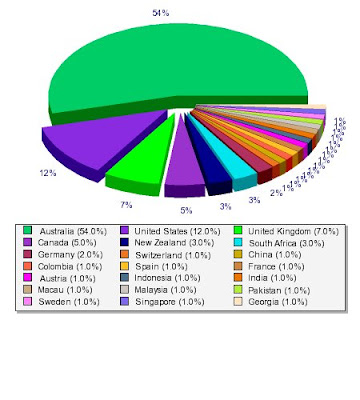One thing I have noticed in examining the search engine listings that bring people to this site is the continuing interest in regional difference in Australia. I thought, therefore, that I might provide some clues to help visitors understand the differences.
The starting point is geography. Geography - landforms, soils, climate - affects every aspect of life. To start with a broad example.
In a coastal tropical region you are likely to find cyclone advice pinned to your door. You will find that you should not swim in the sea during parts of the year because of the presence of dangerous stingers. You may find warnings about crocodiles. You will find the architecture different - more open room, fans.
Compare this with arid Australia. There you will find warnings about driving without water, about what to do if you break down, about the need to let people know what your plans are so that you can be found if lost.
This type of broad difference cascades down into a variety of differences at regional and sub-regional level. Each area has its own pattern of life dictated by the seasons and by varying economic activity.
Then, too, each area has its own history and ethnic mix, again affected by geography. The look and feel of the streetscape varies, not just in terms of arc hitecture but in the people themselves.
hitecture but in the people themselves.
To get a feel for this, look first at the posts on New England, a major regional area centred on the New England Tablelands and the adjoining river valleys spreading to the east and west of the tablelands. This is a large area with its own diversity.
Photo: Hailstorm, Armidale, New England.
Now compare this with the posts on the Kimberley region, a major region on the other side of the continent. You could in fact be in a different country!
Photo: You never know who you'll meet on the Gibb River road. The Kimberleys. Photo by Vanessa Mills
To some degree, these regional differences are concealed by the presence of English as a core common language, although more than a hundred languages are spoken in Australia. They are also concealed by common institutions and a shared if sometimes divergent history. Yet they remain very real, if sometimes unseen.
In my next post in this series I will look at ways to identify and understand regional difference.






+Alice+Springs.jpg)



